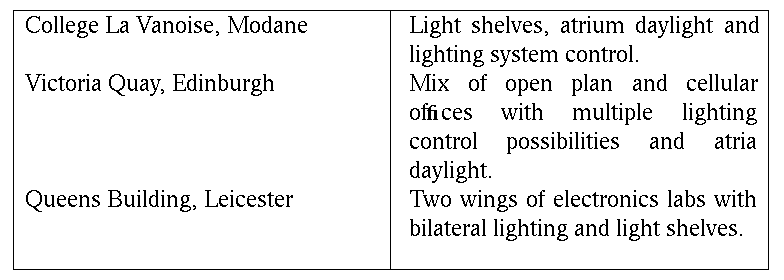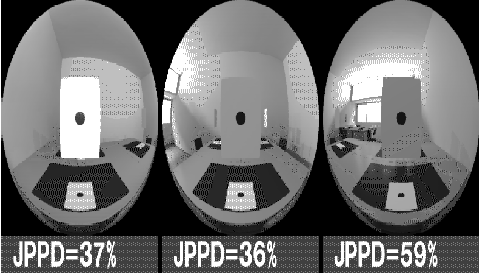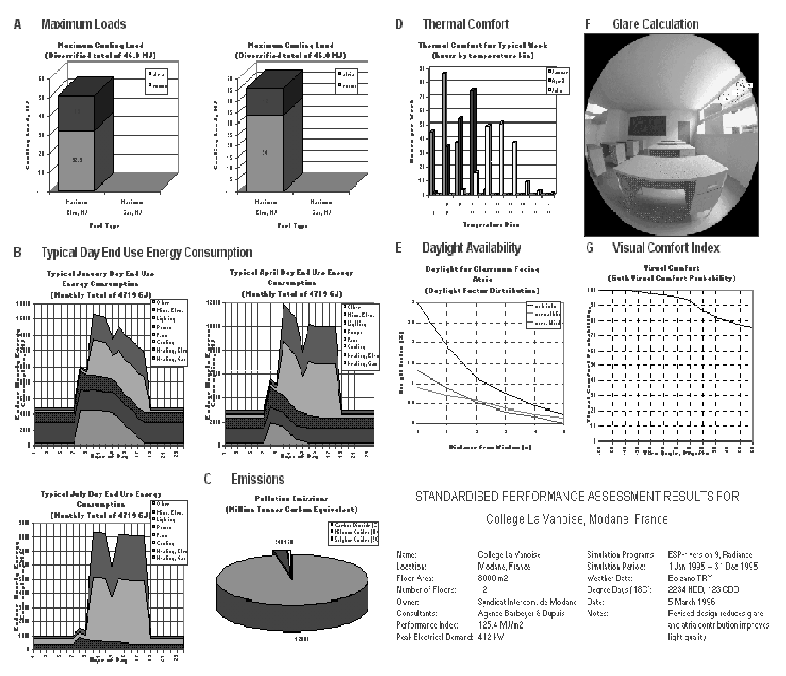
This paper describes the approach taken within the EC's Daylight-Europe project to apply combined thermal/daylight simulations to existing building designs which are representative of European types and climate contexts. The outputs from the performance appraisals are then incorporated within design guidelines for daylighting best practice. The paper elaborates a multi-criteria appraisal set which is used to assess the overall performance of a building and compare this with a matched reference case formed by removing the special daylighting features. Introduction The Daylight-Europe (DL-E) project (Kristensen 1996) aims to produce design guidelines for practitioners who wish to incorporate daylight utilisation techniques within buildings as a means to displace the electrical power consumption associated with artificial lighting. The intention is to produce these guidelines in an architect-relevant format, where notable examples are used to illustrate the operational and integration aspects of the different approaches, and in an engineer-relevant format, where these approaches are quantified using the commonly employed metrics such as daylight factor distribution, discomfort glare indices and electrical power savings. The project's method is to evaluate and exemplify the lighting behaviour of a set of European buildings which typify the range of design types and climatic contexts. To this end, the techniques of monitoring, simulation and post occupancy evaluation are being employed. The role of simulation is to ensure, firstly, that daylight utilisation is not being achieved at the expense of other performance parameters (such as thermal comfort or heating energy consumption) and, secondly, to determine the effects of design and climate parameter variations in order to generalise the case study results.
The DL-E project is targeting around 70 case study buildings, with a selection identified for in-depth monitoring and simulation. This selection comprises:

You can view the details of the modelling and simulation work which has been carried out for some of these buildings. For example:

The DL-E simulation methodology is as follows.
A computer model is formed for each building to a level of resolution which is matched to the embodied technical systems.
A corresponding reference model is then developed by removing the particular daylight capture/control device(s) and adjusting the design as required. The as-built case can then be compared with this reference in order to quantify the benefits (or otherwise) of the daylighting features.
Simulations are carried out using detailed lighting and thermal simulation packages and the outputs collated in the form of a specially developed "integrated performance view" (IPV) which highlights the as-built to reference performance differences for relevant criteria.
Parametric studies are then undertaken in support of daylighting component optimisation.
Finally, the as-built and reference models, along with their IPVs, are contained within an electronic `model manager' which allows 3D browsing, model exporting to CAD, and further exploratory thermal/lighting analysis.
A common Project Manager (Hand et al 1996) environment is used to create the initial models and provide the inputs to the thermal and lighting simulation programs. This tool provides access to databases of material properties, climate, plant components, etc. and supports the attachment of constructional and operational attributes to geometrical models created by CAD packages such as AutoCad. The Project Manager also maintains on-line model documentation and images for each project. The simulation tools used within the project include:
ESP-r:
A building/plant energy simulation environment which originates from the University of Strathclyde in Glasgow (Clarke et al 1996). The system is based on a numerical approach in which building and plant energy flows and their interconnections are represented with the objective of simulating the real world as rigorously as possible. In particular, the system is able to integrate heat, air, moisture, daylighting and power flows, while including special components such as photovoltaic cells, advanced glazings and renewable technolo- gies. For advanced lighting applications, ESP-r is able to pass (automatically) its building representation to the RADIANCE system and receive back, for example, the internal illuminance distribution as an input to a user-specified lighting controller.
TSBI3:
A PC-based thermal analysis program developed by the Danish Building Research Institute (Johnsen and Grau 1994). The lighting systems are divided into general (ceiling) and work place (task) illumination. Control can be different for the two types, with actuation on the basis of 1) the total amount of solar radiation in a zone, 2) the daylight illuminance level at a chosen reference point (computed by the program on the basis of window specific "solar light factors" which allow the window incidence light to be calculated for time varying solar irradiance) or 3) user provided values of hourly artificial lighting use. For each system, six different strategies can be defined, from on/off to continuous dimming. It is also possible to include the effects of solar shading devices.
RADIANCE:
A ray-tracing program supporting the synthesis of images and the quantification of the visual scene in terms of metrics such as daylight factors, directional transmittance and illuminance vectors (Ward 1993). Several sky types are offered as well as surface optical treatments so assessments can be made at different levels of granularity.
JINDEX:
Acting as a post-processor to RADIANCE, this program (Compagnon 1996) assesses the qualitative aspects of daylight in terms of an index, JPPD (Predicted Percentage of Dissatisfied), which relates visual discomfort to any excess/lack of light or inadequate contrasts in the field of view. Figure 1, for example, compares the JPPD values for a work- place located in the same room but with three alternative orientations. A vertical visual reading task is simulated by a black circle printed on a sheet of white paper. In this case the JPPD is shown for a CIE overcast sky with 10000 lux illuminance.

Figure 1: The JPPD index illustrated.
This case study (Figure 2) is a school situated at Modane (1000m altitude) in the south-east of France. The daylight control systems comprise light-shelves located on the classroom facade with "borrowed" light from a central atrium. Energy saving is effected by arranging that lights are switched off automatically every hour and, if required, turned on again by the occupants.

Figure 2: College La Vanoise, Modane.
A reference model was established in which the as-built geometry and construction is preserved but the daylight enhancing devices - the light shelves and windows connecting the atrium and classrooms - are removed. The reference lighting control relies on stochastic manual operation: based on the prevailing internal illumination level and a time varying random number, an algorithm determines whether or not the classroom lights are on at the beginning of the occupied period. If not, the process repeats at subsequent decision points until the lights are switched on. The reverse procedure is then enacted at the end of the occupied period.
In order to compare the as-built and reference cases, a multi-parameter appraisal set has been devised as shown in Figure 3.

Figure 3: Example of the standard DL-E Integrated Performance View.
These diversified total heating loads, by fuel, represent critical plant sizes and hence capital costs. The breakdown of the total, by zone, highlights areas of concern. A comparison of the as-built and reference IPVs for the La Vanoise building revealed marginal differences.
This represents running costs with the breakdown indicating the principal causal factors. It was found that during typical winter conditions the heating energy is greater by 2.8% in the as-built case when compared with the reference. On the other hand, the reference case artificial lighting power consumption is higher by 3.7%. During typical spring conditions, the as-built heating energy is greater by 13.7%, while the reference case lighting power consumption is greater by 36.8%. Clearly, the larger windows in the as-built case, in conjunction with the lower heat gains from lights, results in a higher heating energy consumption. Equally clearly, the electrical power savings resulting from the daylight utilisation significantly outweighs the higher heating energy consumption. Overall, the as-built case offers a significant improvement relative to the base case.
The resultant temperature distribution is used as an indication of thermal comfort with the time-series data frequency binned to allow assessment of problem duration. From the results, it was concluded that the as-built case performed marginally better, especially during the summer period.
This is included to indicate artificial lighting needs. It was found that the as-built case daylight factors were higher (by a factor of 4 or more), especially at points removed from the external facade.
This performance output highlights glare sources within a full 3D colour image (the potential sources are circled). For the as-built case, the upper external window was identified as a possible source of glare because it provides a direct view to the sky vault.
A glare index illustrates the probability of the occupants being satisfied with a particular view direction. For a view direction towards the blackboard, a Guth visual comfort probability of 77% for the as-built case improves to 91% for the reference case where there is no direct view of the sky vault. However, for both cases these figures indicate that there will be no serious visual discomfort.
Based on a comparison of the above performance indicators, it was concluded that the as-built case, relative to its reference, offers:
A methodology has been developed for the combined thermal and lighting appraisal of exemplar buildings in support of design guideline production within the EC's Daylight-Europe project. This includes the notion of an Integrated Performance View by which the benefits associated with a particular set of daylighting features can be ascertained across a range of criteria. The intention is to apply the procedure to around 12 buildings incorporating a range of daylight capture, control, and utilisation features.
The authors are indebted to the European Commission's DGXII who funded this work and to our DL-E colleagues for their technical inputs.
Clarke et al (1996) ESP-r User Manual, ESRU, University of Strathclyde
Compagnon R (1996) `The JINDEX visual discomfort analysis program' Daylight Europe Project Report, LESO-PB, EPFL.
Hand J (1996) `Supporting integrated performance assessments within the design process', ESRU Occassional Paper 96/9 University of Strathclyde, Glasgow.
Johnsen K and Grau K (1994) `Computer program for thermal simulation of buildings' Users' Guide Danish Building Research Institute.
Kristensen P E (1996) `Daylight Europe' Proc. 4th European Conference on Solar Energy in Architecture and Urban Planning Berlin.
Ward G (1993) The RADIANCE 2.3 Synthetic Imaging System Lawrence Berkeley Laboratory, Berkeley.